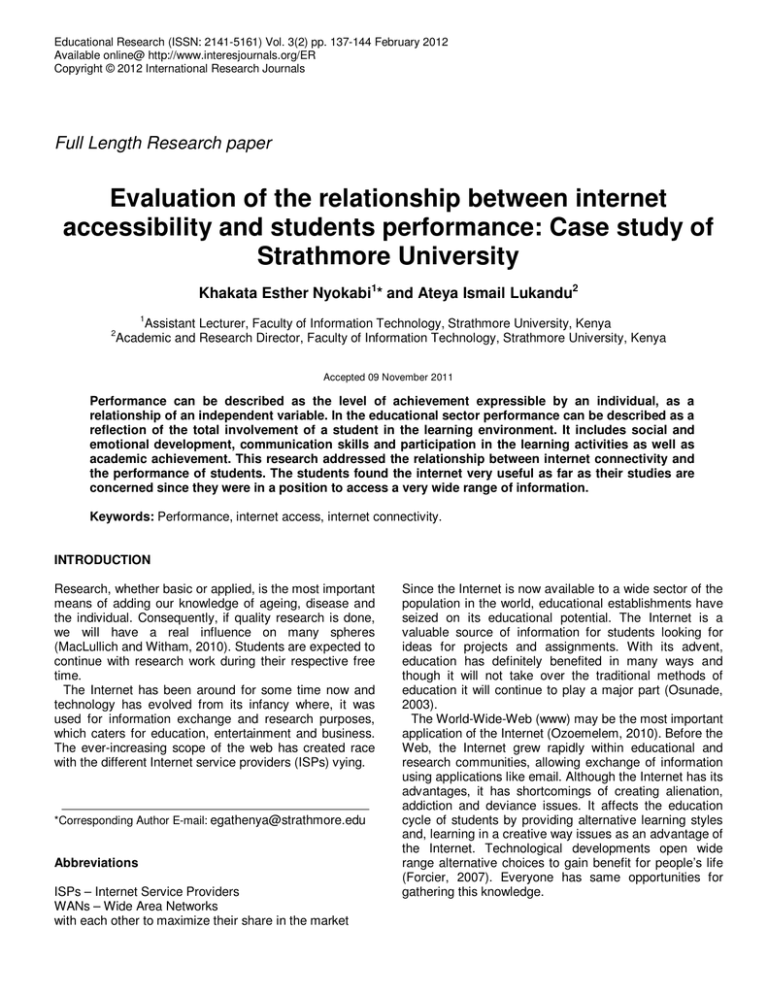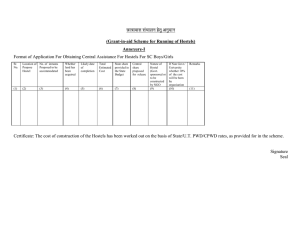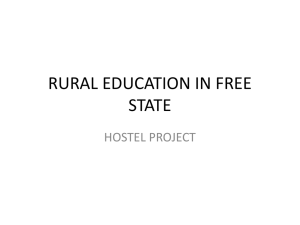Document 14106286
advertisement

Educational Research (ISSN: 2141-5161) Vol. 3(2) pp. 137-144 February 2012 Available online@ http://www.interesjournals.org/ER Copyright © 2012 International Research Journals Full Length Research paper Evaluation of the relationship between internet accessibility and students performance: Case study of Strathmore University Khakata Esther Nyokabi1* and Ateya Ismail Lukandu2 1 Assistant Lecturer, Faculty of Information Technology, Strathmore University, Kenya Academic and Research Director, Faculty of Information Technology, Strathmore University, Kenya 2 Accepted 09 November 2011 Performance can be described as the level of achievement expressible by an individual, as a relationship of an independent variable. In the educational sector performance can be described as a reflection of the total involvement of a student in the learning environment. It includes social and emotional development, communication skills and participation in the learning activities as well as academic achievement. This research addressed the relationship between internet connectivity and the performance of students. The students found the internet very useful as far as their studies are concerned since they were in a position to access a very wide range of information. Keywords: Performance, internet access, internet connectivity. INTRODUCTION Research, whether basic or applied, is the most important means of adding our knowledge of ageing, disease and the individual. Consequently, if quality research is done, we will have a real influence on many spheres (MacLullich and Witham, 2010). Students are expected to continue with research work during their respective free time. The Internet has been around for some time now and technology has evolved from its infancy where, it was used for information exchange and research purposes, which caters for education, entertainment and business. The ever-increasing scope of the web has created race with the different Internet service providers (ISPs) vying. *Corresponding Author E-mail: egathenya@strathmore.edu Abbreviations ISPs – Internet Service Providers WANs – Wide Area Networks with each other to maximize their share in the market Since the Internet is now available to a wide sector of the population in the world, educational establishments have seized on its educational potential. The Internet is a valuable source of information for students looking for ideas for projects and assignments. With its advent, education has definitely benefited in many ways and though it will not take over the traditional methods of education it will continue to play a major part (Osunade, 2003). The World-Wide-Web (www) may be the most important application of the Internet (Ozoemelem, 2010). Before the Web, the Internet grew rapidly within educational and research communities, allowing exchange of information using applications like email. Although the Internet has its advantages, it has shortcomings of creating alienation, addiction and deviance issues. It affects the education cycle of students by providing alternative learning styles and, learning in a creative way issues as an advantage of the Internet. Technological developments open wide range alternative choices to gain benefit for people’s life (Forcier, 2007). Everyone has same opportunities for gathering this knowledge. 138 Educ. Res. Hence, there is need to establish the need and use of Internet by students in their studies. This research was designed to collect information for different parties who wanted to know and address various issues and report it in ways that are going to be of benefit to them. MATERIALS AND METHODS Internet use by students in higher institutions of learning College students conduct research on the web (Lindsay and McLaren, 2000) and its possible to make evaluations on the quality and type of research being conducted. In a similar fashion, one can examine the Internet research habits of students (Burton and Chadwick, 2000) and find that although some depend solely on Internet resources in writing research papers, a majority of the students in the study used a combination of library and online resources. In some institutions where Internet access is relatively reliable and seamless, non-academic purposes represents one of the key Internet usage categories (Mitra and Hazen, 1999). Internet access and use of network bandwidth In networking, bandwidth is used as a synonym for data transfer rate - the amount of data that can be carried from one point to another in a given time period (usually a second). This bandwidth is expressed in bits of data per second (bps) (Bandwidth Management White Papers (Network Management Bandwidth, Network Bandwidth Management) Software Downloads, Definition and Webcasts - Bitpipe. 2010). The most common approach to quality of service today is to over-provision the network bandwidth. Two common forms of Ethernet deployed inside the enterprise are 10 and 100 Mbps, while a T-1 connection capable of carrying 1.5 Mbps of data traffic is often used for enterprise wide area networks (WAN) or corporate connections to the Internet. Rich media communications can consume significant bandwidth on the enterprise network and network provisioning is an important part of any rich media implementation plan. The bandwidth and capacity of the interconnections in the Internet has reached several key points potentially allowing for transmission and use of high demanding research applications. Access to the internet in students hostels Most of the schools in the United States of America (U.S.A) and other developed countries have been providing intranet and Internet connectivity to the stu- dents’ hostels and dormitories for quite a long period of time (Sridhar and Jain, 2006). In Nigerian Universities Internet is used as a tool for learning, teaching and research (Adom et al., 2004). Access to the Internet can permit students to read different newspapers/magazines online for their leisure or educational purposes. In Tanzania, there are a variety of ways in which the electronic resources are accessed by students, but not in the halls of residence (Manda, 2005). The availability of Internet workstations in the universities, in students’ hostels and at home is expected to influence the use of the Internet and library websites by the students (Aman, 2004). This research has not yet been done in Kenya. Models that have been used to measure the extent to which internet connectivity in hostels affects students school work A research done in Nigeria evaluated the impact of Internet browsing on students’ academic performance at the tertiary levels of education (Osunade, 2003). The literature review focused on use of Internet services in tertiary institutions (two distinct models guide current efforts to make use of the Internet in higher education. The first approach seeks to improve existing forms and structures of post-secondary instruction to create "better, faster, cheaper" versions of today's courses and curricula by means of the Internet. The second approach is a more radical model which envisions the Internet as instrumental to a fundamental change in the processes and organizational structure of post-secondary teaching and learning), the cost and other obstacles to OnCampus Internet instruction (the technology is new, very costly, and perhaps too threatening to existing academic structures and traditions. Ignoring the potentials of this new technology for learning will lead to institutions being less competitive and attractive to prospective students) and then the use of technology in education was evaluated (the use of technology in the learning process can be evaluated using the FlashLight Toolkit method. To apply this method three elements are required: a technology (e.g. Internet), an activity for which it is used (e.g. information search), and the educational outcome of the activity (e.g. increased knowledge about topic)). The methodology looked at research design, sample and sample techniques, research instruments and validity indices, data collection and collation and treatment of the data. The research then gives some recommendations regarding access of Internet services, the costing of the services, use of the services by students and the available connection speeds for all users. The research concludes that there is a significant difference in the academic performance of students with Internet access and those without. Nyokabi and Lukandu 139 100% 90% 80% 70% 60% Strongly Agree 50% 40% 30% 20% 10% 0% Agree Neutral Disagree Strongly Diasgree 1 2 3 4 5 6 7 8 9 10 11 12 13 14 15 Figure 1. Usage of internet by students DATA COLLECTION A sample representing the population was considered (10% of the entire population). Questionnaires were distributed since the research was quantitative. The data captured was in the form of percentages. RESULTS According to the extent to which students require and use Internet services in their studies fig 1 • 86% of the students agree that use of the Internet has had an impact on their performance. • 39% feel that the use of the Internet decreases the time needed for their school work. • 86% agree that the Internet has led to improvement in the quality of their school work. • 83% agree that the Internet has increased the effectiveness of their school work. • 79% agree that the Internet has helped increase the quantity of output for the same amount of effort. • 92% agree that the Internet has helped them in their academic research. • 80% agree that the Internet has helped improve their performance in IT related units • 82% agree that they use email, search engines and chats for academic purposes. • 84% normally use email, search engines and chats for leisure or business reasons. • 90% agree that Internet makes learning more interesting • 84% agree that working/studying using the Internet is fun • 91% agree that browsing the Internet is fun • 84% disagree that working with the Internet is complicated and difficult. • 84% disagree that it takes too long to learn how to use the Internet • 91% disagree that the Internet is very complex to use From the above analysis, students generally find the Internet very useful in their studies, fun and interesting in their learning experience. Hence, very few find it hard and not interesting to use. How Internet access has helped or not helped in improving students school work • It helps in research work in assignments hence improved assignments and data output • Helps save time and energy when research has to be done, compared to making physical visits to institutions or reading books. • Leads to time wastage on social sites due to addiction to these sites • Plenty of information is made available online, for example, e-journals. • Variety of information is also available in specific fields. • Fluctuating Internet connections are not very desirable especially when a student has to do research. • It has led to improved grades and acquisition of new knowledge in the IT field, for example, coding skills (for a BCOM student) • Helped in communication with other students on email and on the e-learning site with the lecturers. • There exists too much of irrelevant information 140 Educ. Res. Figure 2. Learning impacts with the Internet Education act available Institution of higher learning Development and implementation of strategies Education access to all individuals Faculties, departments and/or schools for students Student’s studies Availability of computers Use of the Internet by students Internet user awareness Internet use in hostels around an institution of higher learning Access means preferred by students in hostels Access time preferred by students in hostels Amount spent on Internet by student per week Problems encountered by student in hostels Appendix A shows a proposed model. This model can be used in all spheres to check on internet access and performance of students. Figure 3. Proposed model online and hence too much time is spent searching for materials. • It has led to other non-academic functions like chatting and having fun just by browsing. Nyokabi and Lukandu 141 Table 1: Implementation matrix 1. 2. 3. 4. 5. Model component and the measurement metric Education Act i. Are you familiar with the education act in the country? ii. Have you read and understood the contents of the act? iii. Do the contents of the act influence the decisions that you have to make in any way? Development and implementation of strategies i. Is there a strategy in place to help implement the education act in the country, for example, more recruitments for tutors, building relevant curricula? ii. Have you read and understood the contents of this particular strategy? iii. Has the education act been developed to cater for the needs in the country? iv. Are there any facilities that have been put in place to help in the implementation of the existing strategy? Education access to all individuals i. Has the education act ensured access to education by all individuals in the country? ii. Does the education act encourage science, technology and innovation in line with the country’s vision 2030? iii. Has the education act been implemented in various institutions of higher learning? iv. Does the education act aim at improving the productivity and competitiveness of the human resource in Kenya by ensuring better learning facilities for students? v. Does the education act offer equal chances to male and female students in different, socio-economic groups and regions? Institution of higher learning i. Do the students in the hostel belong to an institution of higher learning, for example, a college, university or polytechnic? ii. Are the students in these residents close to their respective institutions? iii. Does the institution provide any extra services to students compared to what is provided in the hostels? iv. Does the institution liaise with the surrounding hostels to ensure that quality services are provided for the students? Faculties, departments and/or schools for students i. Do students belong to different faculties, departments and schools in their institution? ii. Do these faculties cater for the needs of the students and the market at the moment in terms of the courses they offer? iii. Do the students get relevant training to create a globally competitive and adaptive human resource base to meet the requirements of the country’s rapidly industrializing economy? iv. Are students allowed to join a hostel during any year of study or do they join at the beginning of their study period? Table 1 continue below Yes No Remarks 142 Educ. Res. 6. 7. 8. 9. Student’s academic performance i. Do students perceive the Internet as useful in their studies/ academic research? ii. Does the Internet save time and energy for students when they have to do research? iii. Has the Internet helped in improving students grades? iv. Has the Internet helped the student in resolving problems through the use of online forums and blogs? v. Does the Internet waste students’ time through the social networking sites, chat rooms and as a result affect their study time? vi. Is all the information available online considered to be useful by the students? vii. Do the students view Internet use as complex and hard to use? viii. Has the use of the Internet helped in improving student’s school work by encouraging exploration and diversification to various fields? ix. Are students in a position to download resources and use them for their academic work? x. Can the student use online material in the course of their revision? xi. Can the student be in a position to communicate with fellow students and lecturers using the Internet? xii. Do students have interruptions in the course of their online research by fluctuations in the Internet? xiii. Do students consider online information more recent and more relevant compared to information on text books? Use of the Internet by students i. Do the students need the Internet in the hostels? ii. Is the use of the Internet in the hostels popular among the student? iii. Are the access speeds available in the hostels appropriate for Internet access? iv. Do students use the Internet on a daily basis in the hostel? Availability of computers i. Is the quality of computers being used for Internet access good in terms of speed and specifications? ii. Are the available computers in a position to connect to the Internet? iii. Do the computers get serviced regularly by a technician? iv. Have the computers been loaded with the appropriate software to help access the Internet? v. Is there sufficient Internet bandwidth in the hostel to enable students access the Internet? vi. Do students have a favorable environment whenever they need to access the Internet in the hostels? For example, are the computer rooms spacious and not crowded? Internet user awareness i. Do the students have basic skills needed to access the Internet? ii. Is there training offered to the students who cannot use the Internet? iii. Are the students are aware of the importance of the Internet to their studies? iv. Do the students know how to use the provided software to access the Internet? v. Can the students use various means to access the Internet, for example, mobile phones? Nyokabi and Lukandu 143 Table 1. continues 10. Internet use in hostels i. Are there Internet services provided in the hostel? ii. Are the Internet services considered a core service and huge investments done by hostel owners on the services? iii. Are the Internet access speeds are fast and I reliable? iv. Is maintenance and improvements on the Internet done frequently in the year? v. Are Internet services in the hostels better than those provided in the student’s institution of learning or in the cyber cafes? 11. Access means preferred by students i. Do students prefer to use: i. LAN? ii. Modems? iii. Wireless access? 12. Access times preferred by students i. Do students prefer to work on the Internet during: (i) Morning hours? (ii) Afternoon hours? (iii) Night time? (iv) Any time? 13. Ranking Amount spent by the student i. Do students incur a cost to access Internet? (i) Less than 250 shillings? (ii) Between 250 and 500 shillings? (iii) Between 500 and 1000 shillings? (iv) Above 1000 shillings? (v) Nil? Yes 14. 1 2 1 2 1 2 Ranking 3 3 3 4 4 4 5 5 5 1 2 1 2 1 2 1 2 1 2 Ranking 3 3 3 3 3 4 4 4 4 4 5 5 5 5 5 4 4 4 4 4 5 5 5 5 5 1 1 1 1 1 No 2 3 2 3 2 3 2 3 2 3 Remarks Problems encountered by students while using the Internet in hostels i. Do Internet services exist in the hostel? ii. Does the service allow many students to access the Internet at one given point in time? iii. Is the Internet service reliable in the hostel? iv. How is the connection speed and data access using the service? v. Are there enough resources, in terms of computers, to help access the Internet form the respective hostel? vi. Is free Internet access provided in the hostel? vii. Are students able to fund their Internet use while in the hostel, for example, can they afford enough airtime when they have to use a modem or can they afford Internet access fees levied in the hostel? It has helped in the download of software. • It has helped in solving problems through online forums and blogs (for programming issues) and Wikipedia (for initial information available for a given topic). • It has helped in access of revision questions and answers. • It has also helped in access of the most recent information available compared to outdated information available in library books. General learning impacts with the Internet • 93% of the students are motivated by the Internet to explore topics that have not been of major interest before. • 90% find the Internet an effective tool because of the multimedia capabilities. • 71% find the discussion forums very helpful since they provide stimulating thoughts and enhance creative thinking skills. 144 Educ. Res. • 89% can access their course materials easily thanks to the Internet • 32% agree that the Internet forces them to become experts in IT instead of increasing their discipline expertise. DISCUSSION Proposed model Figure 3: Proposed model Implementation of this model will need an implementation matrix as shown in Table 1. CONCLUSION Students generally find the Internet very useful in their studies, fun and interesting in their learning experience. Hence, very few find it hard and not interesting to use. As a result, they consider using the Internet very important in order for them to excel in their academic performance in all the units they study at the university. ACKNOWLEDGEMENTS My thanks to all those who have helped me along this academic journey. To my supervisor, Dr. Ismail Ateya Lukandu for sharing, guiding and challenging me to seek more and more, and hence being the reason and the inspiration behind this document. To Strathmore University, for awarding me a scholarship hence making it possible for me to come this far. To Valentine, Regina, Agripina, Sophie and Donald who helped me in reviewing the questionnaire and in distributing them to their fellow classmates and colleagues in their hostels. To every student who participated in this research. Special thanks to my beloved husband, Simeon for being my driving force even in tough times since the time I began the research. REFERENCES Adomi E, Omodeko S, Otolo P (2004). The use of cybercafe at Delta State University, Abraka, Nigeria. Retrieved November 24, 2010, from http://www.emeraldinsight.com/journals.htm?articleid=861442&show= html Aman M (2004). Use of Malaysian Academic Library Websites by University Students. Information Development, 20(1), 67-72. doi:10.1177/0266666904043803 Bandwidth Management White Papers ( Network Management Bandwidth, Network Bandwidth Management ) Software Downloads, Definition and Webcasts - Bitpipe. (2010, November 24). . Retrieved November 24, 2010, from http://www.bitpipe.com/tlist/BandwidthManagement.html Burton V, Chadwick S A (2000). ScienceDirect - Computers and Composition: Investigating the practices of student researchers: patterns of use and criteria for use of Internet and library sources. Retrieved November 24, 2010, from http://www.sciencedirect.com/science?_ob=ArticleURL&_udi=B6W4941Y87JP5&_user=10&_coverDate=12%2F31%2F2000&_rdoc=1&_fm t=high&_orig=search&_origin=search&_sort=d&_docanchor=&view=c &_searchStrId=1554232063&_rerunOrigin=google&_acct=C0000502 21&_version=1&_urlVersion=0&_userid=10&md5=b3bd2ceeba2b8d4 014a18d60bba62a67&searchtype=a Forcier R (2007). The Computer as an Educational Tool: Productivity and Problem Solving. Retrieved November 24, 2010, from http://www.waterstones.com/waterstonesweb/products/richard+c+forcier/don+descy/the+computer+as+an+educational+tool/5705344/ Lindsay W, McLaren S (2000). The Internet: an aid to student research or a source of frustration? - Learning, Media and Technology. Retrieved November 24, 2010, from http://www.informaworld.com/smpp/content~db=all~content=a713604 811~frm=abslink MacLullich A, Witham M (2010, November 24). BGS Scotland Trainees Pages. Retrieved November 24, 2010, from http://www.bgsscotland.org.uk/Trainees/trainee_research.htm Manda P (2005). Electronic Resource Usage in Academic and Research Institutions in Tanzania — Information Development. Retrieved November 24, 2010, from http://idv.sagepub.com/content/21/4/269.abstract Mitra A, Hazen M (1999). Student attitudes towards Web sites | Academic Exchange Quarterly | Find Articles at BNET. Retrieved November 24, 2010, from http://findarticles.com/p/articles/mi_hb3325/is_1_8/ai_n29089772/ Osunade O (2003). An evaluation of the impact of internet browsing on students’ academic performance at the tertiary level of education in Nigeria. Department of Computer Science University of Ibadan Ibadan. Ozoemelem O (2010). Web affinity: a study of undergraduate students in Nigerian universities. Retrieved November 24, 2010, from http://www.highbeam.com/doc/1G1-233125047.html Sridhar V, Jain P (2006). Cases on telecommunications and networking. Chapter7:The Elusive Last Mile of the Internet. United States of America: Idea Group Publishing.





